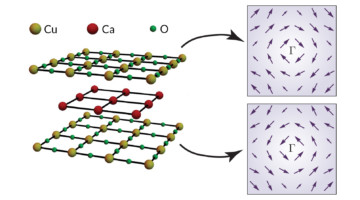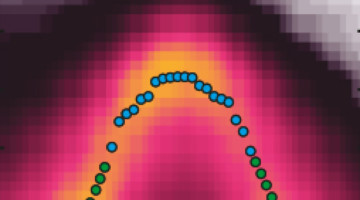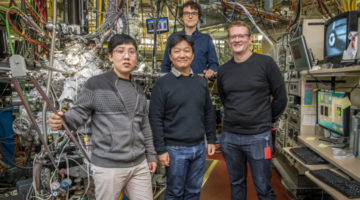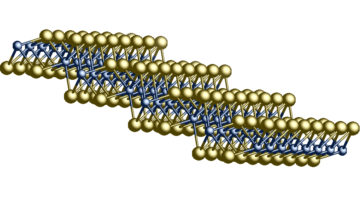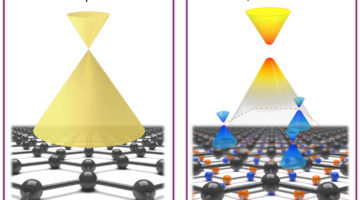A form of spin-momentum locking, similar to the strong linkage between electron spin and momentum in topological insulators, has been found in a cuprate superconductor. The results open a new chapter in the mystery of high-temperature superconductors, suggesting that new, unexplored interactions and mechanisms might be at play. Read more »![]()
![]()
Electric-Field Switching of Topological Phase
Researchers have successfully switched a topological insulator on and off by applying an electrical field. The work represents a major advancement toward the creation of a functioning topological transistor that would allow devices to operate more efficiently at lower power than conventional electronics. Read more »![]()
![]()
Revealing Hidden Spin: Unlocking New Paths Toward High-Temperature Superconductors
Researchers used spin- and angle-resolved photoemission spectroscopy (SARPES) to uncover a distinct pattern of electron spins within high-temperature cuprate superconductors. The discovery provides new insight into materials with potential for super-efficient power transmission without any loss of electron momentum. Read more »
Topological Matters: Toward a New Kind of Transistor
An experiment has demonstrated, for the first time, electronic switching in an exotic, ultrathin material that can carry a charge with nearly zero loss at room temperature. The ease in switching the material from an electrically conducting state to an insulating, or non-conducting state, bodes well for its future transistor applications. Read more »
Researchers Confirm New 2D Topolgical Insulator
Researchers have established that a particularly stable form of WTe2 is a two-dimensional topological insulator, confirming recent predictions. The findings should provide new opportunities for fundamental studies of topological phenomena and for next-generation spintronic applications. Read more »![]()
![]()
ALS Work Highlighted in DOE Top 40 Countdown
To celebrate DOE’s 40th anniversary (October 1, 2017), the Office of Science (SC) collected 40 scientific milestones from the previous 40 years, each one supported by SC. The ALS played a key role in two of the milestones: 2005 (ribosome) and 2009 (topological materials). Read more »
2D Material’s Traits Could Send Electronics R&D Spinning in New Directions
Working at the ALS, researchers have found another family of materials where they can both explore the physics of 2D topological insulators and do experiments that may lead to future applications. The material—known as 1T’-WTe2—bridges two flourishing fields of research: that of so-called 2D materials and topological materials. Read more »
Strain Turns Tin into a 3D Topological Dirac Semimetal
A small amount of compressive strain turns a nonmetallic form of tin into a 3D topological Dirac semimetal—a kind of “supermetal” with very high electron mobility. With its rich topological phase diagram, the material shows promise for both novel physics and eventual device applications. Read more »![]()
![]()
Altered States in Graphene Heterostructures
ARPES directly reveals for the first time how electronic states are altered when epitaxial graphene is deposited on a substrate of hexagonal boron nitride (h-BN). The interaction between the materials in this heterostructure greatly improves its suitability for advanced, ultralow-power device applications. Read more »![]()
![]()
A New Universal Parameter for Superconductivity
Scientists have been researching high-temperature (high-Tc) superconductors for decades with the goal of finding materials that express superconducting capabilities at room temperature, which would be a requirement for practical and cost-effective applications. The newest materials to gain scientific interest are iron-based superconductors, and the latest research from the ALS on these materials indicates a new factor that determines their superconductivity. Read more »![]()
![]()
